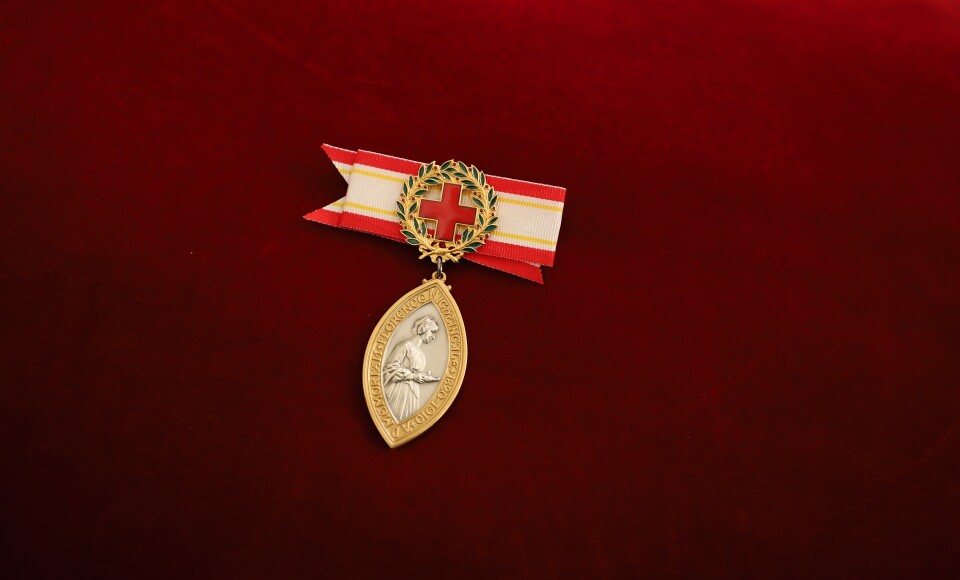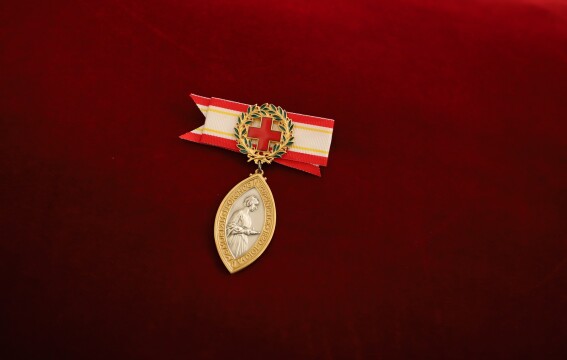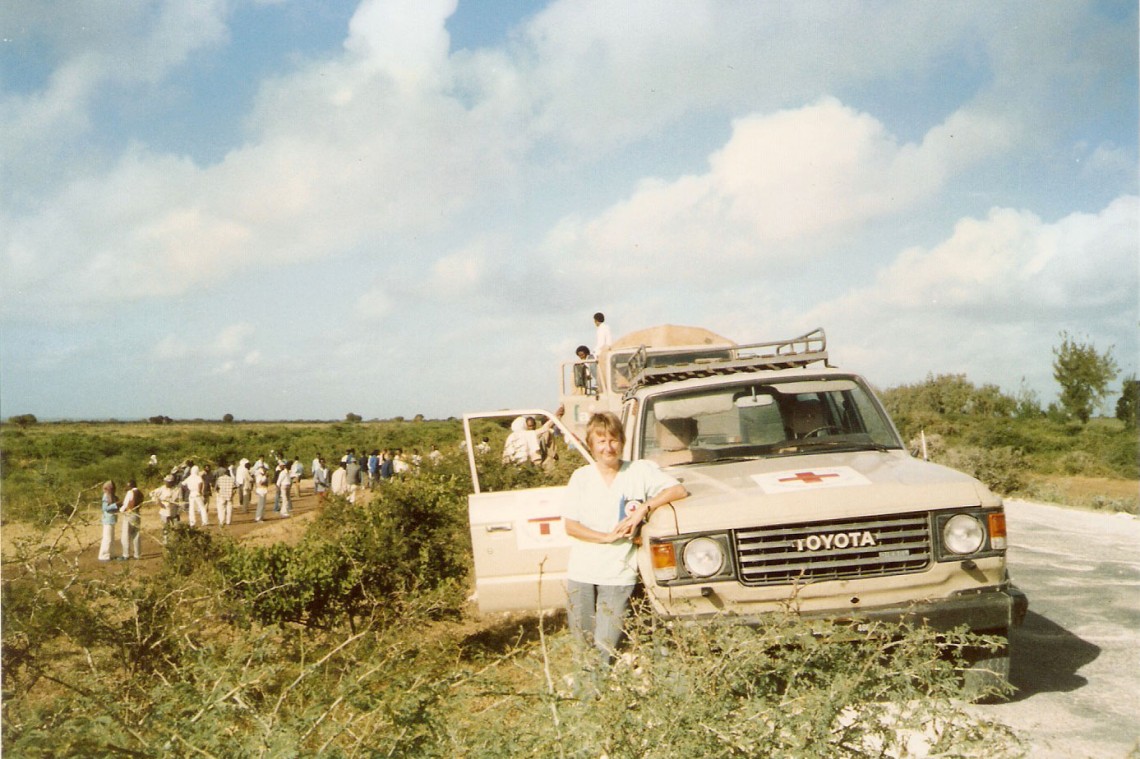A little bit about the Florence Nightingale Medal
6 May 2024


The Florence Nightingale Medal is the highest Red Cross award for nurses and voluntary nursing aides.
Named after the famed British nurse, it honours people who’ve distinguished themselves in times of peace or war through:
- Exceptional courage and devotion to the wounded, sick, or disabled, or to civilian victims of a conflict or disaster.
- Exemplary services or a creative and pioneering spirit in public health or nursing education.
The medal is awarded every two years to 50 people across the world. Since 1920, 31 New Zealand Red Cross nurses and voluntary nursing aides have been awarded the medal. The most recent was Felicity Gapes in 2019.
The award was launched by the International Committee of the Red Cross (ICRC) in 1912 and was first awarded in 1920. Kiwi Hester Maclean — Director of Nursing at the New Zealand Department of Health and Matron in Chief of the Army Nursing Service — was among the first group of recipients.
ICRC have made changes to the criteria over the years. In 1934, nursing aides became eligible. Devotion to the sick and wounded during war or peace — with a reference to disasters — was also added. Three New Zealand Red Cross voluntary nursing aides who weren’t registered nurses have received the award:
- Irene Campbell in 1947
- Edna House in 1951, and
- Doris Ramsay in 1961.
From 1981, the medal could be awarded to nurses and aides who’d distinguished themselves in promoting health and preventing disease. In 1991 ‘exceptionality’ was broadened to include personal sacrifice, as well as in areas like public health and nursing education. Men were also awarded the medal for the first time that year.

Gail Corbett, Guru Dev Singh, and Barbara Turnbull, recipients of the Florence Nightingale Medal in 2017.
The list of Kiwi recipients shows how the roles and service of nurses with Red Cross have changed over time. The first Kiwi recipients were nurses and voluntary aides associated with the First and Second World Wars, as well as two Health Department directors of nursing. Since 1969, Kiwi recipients have been registered nurses who’ve served with our international Movement as delegates. They’ve served not only in conflict zones, but in the aftermath of disasters and in refugee camps. When deployed, they’ve provided medical care, as well as training in public health, first aid, and the basics of international humanitarian law.
It’s impossible for us to showcase all the service and incredible work of every one of our Florence Nightingale Medal recipients over the last 100 years. This is a snapshot of some of the extraordinary people who’ve been recognised for their work, showing how the work of our nurse-delegates has progressed and evolved over decades.
Moya McTamney, CNZM MBE – 1969 recipient

Moya McTamney, CNZM with Vietnamese children, 1968.
“From the moment you go into an operation you must be thinking of how to withdraw from it.” This was one of the lessons learned by Moya McTamney, CNZM during her many years of working for Red Cross. In 1968, she became the first trained nurse to serve New Zealand Red Cross on an overseas mission. In 1969, she was our first nurse-delegate to be awarded the Florence Nightingale Medal.
During her years as an international delegate, she twice deployed to what was then South Vietnam, the Pacific, the Thai-Kampuchean boarder, and Sudan. It was on her first two missions to South Vietnam that she “learned her trade”, but for her — as with all delegates — each placement was a learning experience. A honing of skills and tempering idealism in response to the realities of the situations faced on each deployment.
Moya made a Member of the Order of the British Empire for services to Red Cross in 1972. She was made a Companion of the New Zealand Order of Merit in 1999 for services to nursing.

In 1967, Eardley Button — the National President of New Zealand Red Cross — asked Moya if she wanted to join the first Red Cross welfare team heading to South Vietnam. She was the only woman on the team and received a basic briefing before leaving New Zealand – there were no previous teams to share their field experience. The team deployed in 1968 soon after North Vietnamese forces launched the Tet Offensive.
Most of her work in South Vietnam saw her helping Montagnard refugees, who comprise more than 19 different indigenous ethnic groups. One of their main health problems was hookworm, which caused anaemia.
Moya started helping by using basic techniques to cure people’s hookworm, but quickly learned that this approach wasn’t sustainable in the long-term. It didn’t address the gap that would be left when her deployment ended. So, during her second mission, she trained local women in simple procedures and using basic medicines to help people in their own communities. Moya the surgical nurse had transitioned to Moya the public health worker.
Judy Owen – 1995 recipient

Judy Owen in South Sudan, 2014.
Born in Whanganui, Judy Owen served New Zealand Red Cross and our wider international Movement for over 35 years. She’s deployed to many countries over her time as a delegate, including multiple deployments to the Middle East, Asia, Africa, the Balkans, and North Caucasus regions.
She’s deployed in the aftermath of disasters, including the 2004 Boxing Day Tsunami in Banda Aceh, Indonesia which killed over 300,000 people. The ongoing civil conflict in the region compounded the extraordinary devastation the tsunami caused. She’s also deployed during conflicts in Europe, Africa, and the Middle East to help vulnerable people. She’s been terrifyingly close to bombings, as well as held at both gunpoint and knifepoint while working in conflict zones.
When she started as a delegate, the work was mostly about caring for the wounded. This changed in the 1980s and 1990s, when the work evolved to include checking on the health of detained people and more public health work in areas affected by disasters or conflict.

August 1988 — over 30 years ago — I had the privilege of being involved with the release and repatriation of prisoners of war who were flown back to their country to be with their families. The Ogaden War took place from July 1977 to March 1978 between Somalia and Ethiopia due to a territorial dispute over the Ogaden region. It was claimed by both countries. During the war, the International Committee of the Red Cross (ICRC), together with the Somali Red Crescent Society, provided medical and surgical assistance to wounded combatants and civilians in Mogadishu.
I was trained as a nurse and as part of an ICRC surgical team and charged with looking after these weapon-wounded. At the time, the Somali government had flown in military and civilians from fighting in the north and brought them back down to Mogadishu. They were put in a building right on the coast, a big empty warehouse-like compound which was a military hospital known locally as Martini Hospital.
On 3 April 1988, Ethiopia and Somalia signed an agreement normalizing their relations. The Agreement provided for the repatriation of all prisoners of war and civilian internees. With the agreement of both countries, the ICRC facilitated the process, in conformity with its specific mandate. As a result, thousands of individuals returned home after years in their places of detention.
As one of my colleagues, Ali Sidow Osoble of Somali Red Crescent said, “It was a happy time. I felt it was a happy moment, a moment of trust, for all of us.’ I remember when the prisoners of war finally saw the plane, and they went up, that was when the excitement got a bit contagious. It was something you couldn’t envision. People being prisoners in another country and all of a sudden, they have got the opportunity to go back home. You know, they walked down the gangplank from the plane and kissed the ground. I found it a very emotional experience as you could feel the emotions of the people in the plane waiting to disembark. When they started to kiss the ground, I was very grateful for my sunglasses!”
Shared as part of the Geneva Conventions 70th anniversary commemorations on 5 August 2019 and featured in the ‘IHL Human Stories report’.
Felicity Gapes – 2019 recipient

Felicity Gapes in the field.
A registered nurse since 1985, Felicity Gapes started working within our international Movement in 2004. She was prompted by her experiences as part of with the Royal New Zealand Nursing Corps. While in the New Zealand Army, she served on peacekeeping missions in Bosnia and Herzegovina and Timor-Leste, as well as a disaster relief mission in Papua New Guinea. Her Red Cross deployments have taken her to the Pacific, Somalia, South Sudan, and Myanmar.
Her roles while deployed have included clinic management, preventative health intervention, first aid training, monitoring the health of people in detention, and programme management. During her Somalia deployment from 2009 to 2012, her main role was remotely managing 51 healthcare facilities and mobile teams.
During her work as a nurse-delegate, Felicity has contended with complex and large-scale operations, ongoing conflict, and clan-based issues caused by political instability.

Let me take you to South Sudan, December 2013 – a conflict has broken out among many different armed groups spreading fear and panic. One of the main groups was one local people called the White Army. Little was known about them – apparently the name is linked to the white ash from burnt cow dung which they cover themselves in to protect against insects. They’re rural Neur people, known for cattle raiding, with no conventional education or command structure.
After some serious networking, the White Army agreed to spend one day with the ICRC. That meant four hours of international humanitarian law and four hours of first aid, divided by two groups of about twenty each. What to do in four hours? How to engage and keep them engaged while bringing in elements of international humanitarian law and raising awareness of protection of health care workers, which is intrinsic to ICRC first aid? PowerPoints are pointless. There may be no electrical power, for one thing. Flip charts and lecturing can be boring. International humanitarian law is sometimes written in quite dry legal form.
I sat with the Nuer field officer I would work with. I asked him about sports and what he did as a child growing up. He told me that they grew up practicing kwer — non-weaponised wrestling — and dwar — wrestling with sticks and knives.
At the training day, there was little initial engagement. Some clearly weren’t interested in first aid. So, I grabbed two of the not so engaged ones. Through the field officer’s translation, told them to “pretend that they were five-year-olds and to wrestle each other”. “We’re not five-year-olds!” was the pretty quick response. However, after bit of convincing and some encouragement from the now engaged audience, they started pretend-fighting.
Eventually one man was down, and I told him to “kick him while he’s down”. I pretended to boot him. An immediate response from the group – “you can’t do that! ”and “that’s not allowed!”. “Why not?“ I asked. “Because he’s hurt and can’t fight back” they said. “Ah, so you have rules about your fighting and about injured people” I said. We discussed a bit more about their rules – the fighting stops when someone is down — or with dwar if someone is bleeding — and senior people control the fight. I then brought in what international humanitarian law and the Geneva Conventions say about treatment of injured combatants, relating it to their rules.
After some practical first aid it was time to transport the casualty. I picked two healers and two stretcher bearers and promptly ‘shot’ them all. That generated discussions on protection health care workers and the impact on injured weapon bearers, not only from their group but the responsibilities to injured opposition.
The team all agreed that the engagement and interest was obvious and some of the questions were thoughtful and very relevant. The combination of first aid and international humanitarian law sessions seemed to consolidate the messages, and this experience highlighted the need know your audience. From this initial engagement, ICRC has managed to strengthen the relationship with the White Army, and still work with this group today to promote better livelihoods.
Shared as part of the Geneva Conventions 70th anniversary commemorations on 5 August 2019 and featured in ‘IHL Human Stories report’.
More information
- See the full list of Kiwi Florence Nightingale Medal recipients.
Honours and awards - Find out more about international humanitarian law.
International humanitarian law - Check out our international humanitarian law learning resources, including the ‘IHL Human Stories’ report, which features Judy and Felicity’s stories.
International humanitarian law learning resources - Learn more about the International Red Cross Movement.
International Red Cross Movement - Find out more about our history, from wartime service to Meals on Wheels.
Our history - In times of disasters, conflict, and other emergencies, we respond to the needs of vulnerable people around the world.
What we do overseas
